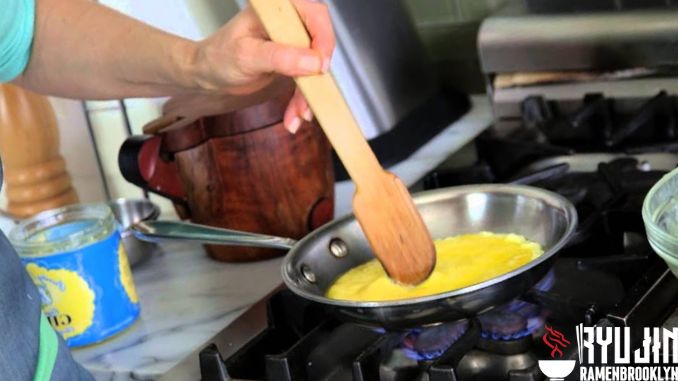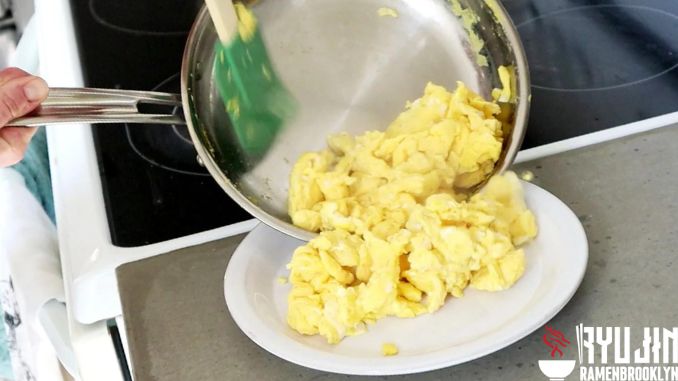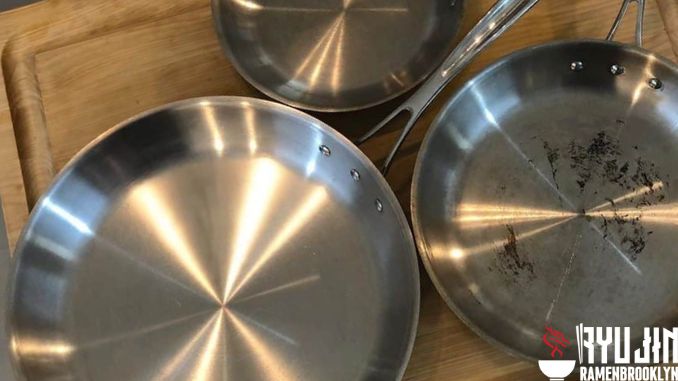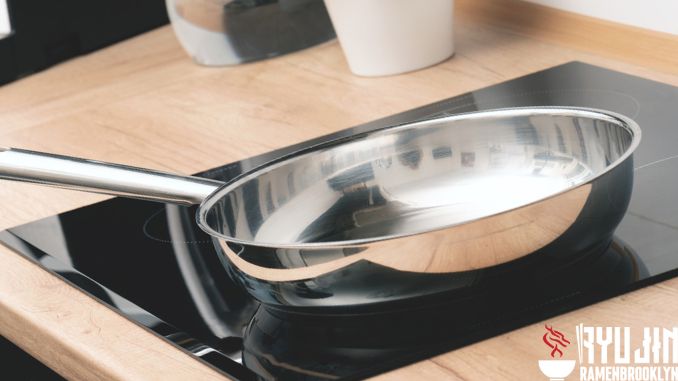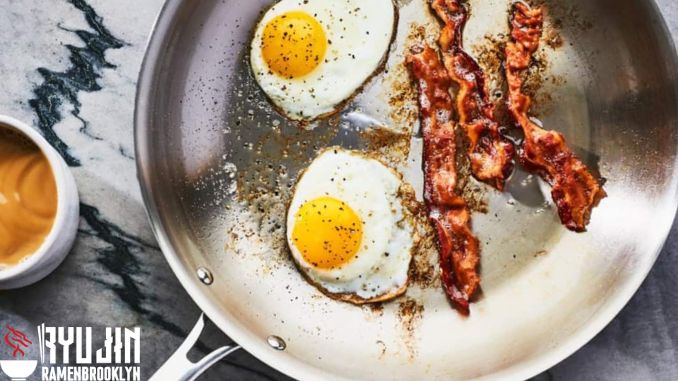How to Use Stainless Steel Pans Without Sticking
There are many different types of cookware on the market these days, but one of the most popular is stainless steel. Stainless steel pans are made with a combination of metals, including chromium and nickel, which gives them their distinctive shine and also makes them durable.
Like most people, you probably think of stainless steel as just another kitchen surface option – like granite or marble. But stainless steel is so much more than that! It’s one of the most versatile materials for cooking out there. Here’s why: stainless steel doesn’t warp, meaning your food will cook evenly every time. It doesn’t rust, so your pans will last for years, and it’s heat-resistant, so you can use it on the stovetop or in the oven.
They’re a great choice for everyday cooking because they heat evenly and can be used on all surfaces, including induction cooktops. Plus, they’re easy to clean – a quick wipe with a soapy cloth is usually enough. Stainless steel is definitely worth considering if you’re in the market for some new pots and pans.
You may have heard that stainless steel pots and pans stick to food when cooking, so many people still prefer using nonstick cookware. However, in addition to deteriorating over time, some poor quality non Stick coatings can disintegrate, contaminating your dishes which is harmful to our health. Again, this isn’t something you need to worry about when using stainless steel pots or pans.
Stainless steel cookware is not only a great addition to any kitchen but it can also be used in many different ways. It has superior heat retention and durability, allowing you to use your stainless steel pans for longer periods without worrying about them breaking down or burning food, making them perfect if high-quality results matter most when cooking!
When it comes to stainless steel, the best way is always to use them correctly. There are many benefits to using stainless steel pans when cooking, but one of the most common issues people have is that their food sticks to the pan.
If they use their pan incorrectly- either too hot or cold temperature can lead to a stuck omelet which then ruins breakfast for everyone at home, including yourself. This can be frustrating and costly, resulting in wasted ingredients. A few simple rules will help you get started and ensure your food doesn’t stick in any of those beautiful pans!
In this blog post, we will share some tips on how to use stainless steel pans without sticking. By following these tips, you will be able to cook your favorite recipes with ease!
See more: Does Anodized Aluminum Wear Off?
Why Does Food Stick to Stainless Steel Pans?
Heating your stainless steel pan before adding oil can help prevent food from sticking and make cooking more successful. It’s no secret that most people use nonstick pans where preheating without oils for too long is an avoided topic, but this works best with metal utensils!
Heating the dishwasher-safe type of material causes molecules inside them to move closer together, which allows bonds between components like proteins or carbohydrates to break down easier, resulting in a max surface area exposed for converting heat into pressure; causing foods not only to brown faster but also lessening the chance of sticking.
The metal pores of the pan may appear smooth to a casual observer, but lots are going on beneath that surface. As you heat your pans and their size expands with every passing moment, so do these small gaps between different pieces within each layer – until everything becomes one solid mass! The result is an impeccably cooked meal without any sticking or unnecessary oil contamination because all food slides easily off its sleek exterior.
Heating metal pans can be tricky and requires you to pay close attention. If oil is added before they have been preheated, it will cause an expansion and closing of pores which could lead to food getting stuck in between gaps during cooking or cleaning later on down the line; this becomes even more problematic when dealing with cast iron cookware because those types contain tons amounts collagen – meaning any burned particles left over after making your meal won’t come off easily!
When heated up properly, the hot oil helps fill any leftover micro-crevices in your pans and forms a protective barrier between you and sticking. In addition, the steam created when food reacts with this cooking fat prevents it from bonding too tightly onto surfaces so that, no matter how much moisture there may be inside or outside, their bodies can always separate easily without anything sticking!
One of the most common cooking errors is using a too cold pan. When this happens, there won’t be any lifting effect, so your food ends up sticking and not getting cooked! You could also end up with a burnt dish if your pan is too hot. The particles from the food will also stick and cause an unpleasant aroma, which might make for some parts that don’t cook properly because they’re still raw in spots!
See more: Seasoning a Stainless Steel Pan
How to Use Stainless Steel Pans Without Sticking
Preheat Your Pan
Many factors can affect the stickiness of food to your stainless steel pan, but one important factor is temperature. If you don’t have enough heat or if it’s too hot for a certain recipe and cooking technique will result in stuck-on residue on all foods cooked with those methods, which could ultimately ruin them before they’re ready!
Temperature control is key to not having food stick to your stainless steel pan. Suppose you get it too hot or cold. In that case, that will cause an unwanted outcome of sticking and un-sticking when cooking with oil in the future because there won’t be enough incentive for water molecules wanted to join together across different surfaces until they’re heated up again by increased friction caused by higher temperatures around 350 degrees Fahrenheit (176 Celsius). For this reason alone, you should always preheat your stainless steel pans before adding any type!
To start, place your empty pan over medium heat and leave it for about 2-3 minutes. You can either do the Water Droplet Test or add oil directly to see if cooking is done right before adding ingredients such as vegetables that might stick less than others due to their skins being removed (such as potatoes).
There’s no need to cook on the highest heat. This might increase your chances of burning and sticking food onto the pan! Maintaining an even, low-to-medium flame is all that you’ll ever really need when trying to get those beautifully golden brown edges without sacrificing flavor or texture in whatever it may be cooking.
Use The Water Droplet Trick
When you are cooking, the last thing on your mind is whether or not it’s too hot. But when preparing food for a crowd and trying out some new recipes at home with friends who might be coming over, let’s just say there will probably never happen again! The water droplet test can give us peace of mind during these situations by ensuring that our pans have been heated accordingly before adding oil/butter etc.
This simple method works best if done alongside others because everyone gets an opportunity to see how fast things change from recommended temperatures (on the package) into the “oh no, it’s too late!” red zone, which should be avoided at all cost!
Ensure you only do this test with a dry pan before adding oil. You don’t want water flicking into your hot and oily mixture, now do we? Once your empty pan has been left to heat up over medium-high for about 2 or 3 minutes, carry out the water drop test and make adjustments. Add a few drops of warming liquid (water is best) onto one side at a time until you notice how quickly it evaporates upon contact; this will help prevent any unwanted spattering!
-If the pan is too hot: The water droplets will immediately disperse and separate into many smaller ones. They’ll move very fast in your frying pan, almost as if trying to “escape” it! This is because when metals come into contact with open flames or high temperatures such as those found on gas stoves, the top reflects some heat towards their source, which causes them to expand rapidly, deforming accordingly before eventually brittle-breakdown under pressure leading us here. Any foodstuff cooked within proximity of these areas will become dry, overcooked, and burnt.
-If the pan is too cold: The water droplets will simply sit there without evaporating or changing shape. This is how you’ll know that it isn’t hot enough yet, and further heating will be necessary; remember to be patient because if you rush things, you might end up with food that sticks or burns easily.
-If the pan is just right: One or two of the water droplets will start to change shape before evaporating, while the rest remain relatively unchanged. Perfect! You’ve reached an ideal cooking temperature for your stainless steel pan.
To ensure that your food is perfectly cooked, you must add enough oil. Adding too little can lead to sticking and burning, while adding more than needed might cause flare-ups or smoke during the cooking process resulting in undercooked foods which contain high levels of unhealthy fats!
When using stainless steel pans with nonstick surfaces, it’s important not only about how much fat we use but also when– before pouring our desired amount onto preheated plates/utensils, remember always wipe down any droplets left by previous uses so as no splatter all over yourself (or kitchen).
If you’re looking for an even cook, keep the oil moving around so that it coats the entire surface area of your pan. You can do this by tilting the frying pan or using a spoon/spatula! Another way to help ensure an even cook is by using smaller batches; this will also prevent sticking and burning.
It’s important to use enough oil when cooking delicate foods like eggs and vegetables, but less for bigger proteins. You want a lot of fat to prevent sticking to large searing meats such as steaks or whole chicken breasts. So typically, if the flour is added during preparation, this will help create better browning because it acts like sandpaper on metal– scraping off burnt bits while leaving behind delicious flavor!
The key to cooking meat is giving it time in the pan. Once a crust forms on your cookware, you can flip over any browned bits without worrying about sticking and finish off this side with an oven-safe spatula for easy removal from the plate!
It’s also worth noting that if leftover caramelized spices or flavors are left behind after searing them first before making sauce out of these precious ingredients, just turn them into something special by adding more fat so they won’t ruin all those hard work put into creating delicious dishes.
Adding Oil or Butter Directly
While the water droplet test is simple and effective, it does take some time to complete. With experience, you can also tell when oil should go onto your pan without using this technique! Experienced cooks and those wishing to skip the test can add oil directly to their preheated pan. They will observe how it moves around when they start cooking, which tells them whether more is needed or not.
You can tell your pan is ready for cooking by hovering the back of your hand over it. You should do this at a safe distance (as a guideline, 6 inches or 15 cm above where you would like to begin). Make sure not to touch any part on top so as not to burn yourself!
When adding oil to a hot pan, it’s important not only that you follow the proper temperature guidelines but also safety precautions. For example, before starting any cooking process or using utensils with metal handles near an open flame (such as gas burners), ensure your hands are well-protected by protecting them against heat sources like kitchen gloves which will protect both themselves and others around your work area from injury due accidents happen fast!
-Your pan is too hot: you can see the striations in anticipation of an angry flashpoint, or ripples appear before your eyes as if the bottom has been dipped into a liquid.
-Your pan is ready: a light sheen should be present, and the oil should flow easily without resistance.
-Your pan is too cold: the oil sits like a puddle or beads up and rolls off to the side.
The best way to avoid overcooking your food is by having all of its ingredients prepped before you start cooking. However, it’s also important not to wait too long in between adding new items, or they can easily burn!
The depth of flavor that butter adds to our food makes it a popular choice for some cooking. You can use stainless steel pans with this technique just as you would oil, but be mindful about how hot your pan gets before adding the fat because too high temperatures may cause unpredictable behavior from certain ingredients like proteins denatured when heated above 180° F (82 °C).
This is the temperature at which water boils, so it’s a good guideline to keep when cooking with butter. If unsure, start lower and work your way up until you find the perfect heat for what you’re making!
If your pan starts to smoke, that’s a sign that it’s too hot and the oil has begun to break down. Remove it from the heat immediately and let it cool down before continuing.
Dry Food
Water is a magical liquid that can do many things, like bring the temperature of your oil down when you are cooking with vegetables. If they have just been washed, ensure all excess water has evaporated before using them to prevent overcooking! Pat meat, too, will remove any surface moisture from its flesh, so it does not get greasy during cook time.
When you are ready to start cooking, ensure your food is as dry as possible. If there is any water on the surface of your ingredients, it will cause the oil to splatter and make a mess. It can also lead to uneven cooking because the water will evaporate and leave behind overcooked bits of food.
Get Your Food to Room Temperature
The key to making sure your food is cooked properly and doesn’t stick, according to some experts in the field of cooking (such as chefs), starts with one thing – getting it at room temperature, just like how you want a pan heated up before putting butter or oil onto its surface so that fat can spread around easily. When adding cold food to a hot pan, you must wait for the temperature of both items before putting them together. This will help avoid bacterial growth and sticking caused by low heat levels.
The next best way to prepare your food is by having it reach room temperature — or at least close. Of course, this means removing the fridge beforehand and letting those ingredients take their time while you work on something else! The only tricky part about this process? It depends on what dish we’re talking about: some foods like thick steaks need more patience than others. For example, thinner cuts of meat or chicken breast can be taken out 20-30 minutes before cooking, while the thicker ones (like a New York strip) may need an hour or so.
This method is also good for ensuring that your food cooks evenly throughout. When all the ingredients are at the same temperature, they will cook at approximately the same rate meaning there’s less chance for any under- or overcooked bits.
Be Patient With a Sear
If you’re searing a steak, the pan will let you know when it’s ready to go. That’s because of how beautifully browned out an outside produces during what is known as “searing.” If, at any point, it feels like something isn’t sticking while cooking your food item, just give them more time! You should only sear once on each side and shake up their kitchen before flipping over, so nothing burns or sticks onto other pans nearby (though do not violently lift off).
Don’t Overcrowd The Pan
This one might seem like a no-brainer, but it’s worth mentioning! If you’re cooking multiple items at once, make sure they have their own space in the pan so that heat can circulate evenly and prevent sticking. It’s also important not to move things around too much while cooking, as this can cause sticking. Let each piece cook undisturbed for the best results.
If you’re using a smaller pan, cook in batches rather than trying to fit everything in at once. It might take a little longer, but it’ll be worth it in the end!
Use Non-Stick Sprays or Oils Sparingly
While nonstick sprays and oils can help to prevent sticking, it’s important to use them sparingly as too much can cause build-up on your pan over time. This can affect how well your food cooks and how long your pan will last in general. If you decide to use one of these products, make sure to evenly coat the pan’s surface before adding any food.
Another pro-tip is to use a paper towel to spread the oil or spray around so that you don’t use too much. And if you’re looking for a more natural option, you can try rubbing the inside of the pan with half a lemon!
Use Non-Stick Cooking Spray
If you don’t have time to wait for your food to come up to room temperature, or you’re in a rush, another option is to use nonstick cooking spray on your pan. This will help create a barrier between the metal surface and what you’re cooking, giving you a little more leeway with how long you can sear or cook something before it starts to stick.
Keep in mind that this is a short-term solution and should not be used as a replacement for proper pan preparation! It’s also important to choose a quality cooking spray, so you don’t end up with unwanted chemicals in your food. Look for brands labelled “PFOA-free” or “PFOS-free” to be on the safe side.
Use the Right Amount of Oil/Fat
Adding too much oil to your pan can cause sticking, but not adding enough can cause burning. It’s all about finding the right balance, and unfortunately, there is no magic number we can give you since it will vary depending on the size and type of pan you’re using.
A good rule of thumb is to start with a small amount (1-2 tablespoons) and add more if needed. Of course, you can always add more oil, but you can’t take it away once it’s in the pan! It’s also important to ensure that your fat is evenly distributed across the surface before adding any food.
If you’re cooking something that tends to stick easily, like eggs or pancakes, you may need to increase the amount of fat you use. On the other hand, if you’re making something that doesn’t usually stick, like vegetables or fish, you can get away with using less.
Cleaning and Caring for Your Pan
Cleaning your pan is important to ensure that you can cook an even, clean surface for all ingredients. Small food particles can create contact points with new ones, leading them to stick more easily than if there were no residue on the cookware beforehand. Remove this by cleaning properly but be cautious not to use hot water because it could warp sensitive materials such as steel or aluminum steel etc.; let cool first, then wash away any debris immediately afterwards.
Cleaning a stainless steel pan is easy when you start with warm water. To clean the inside of your cooking equipment, use paper towels and then scrub away any leftover oils or food bits stuck in between cracks until they come out easily for disposal later on downstream! If this did not work, try following these steps again but add some more hot water while still wet before brushing/scraping, etc., especially if there have been stubborn stain accumulations caused by hard-to-reach places like under faucets where soap suds may build up during daily household activities.
After cooking on your stainless steel pan, it’s important to remove any burnt-on food as soon as possible. Soak the pan in hot soapy water for a few minutes before scrubbing it with a non-abrasive sponge or cloth. If you have a dishwasher, feel free to use it for easier cleanup!
To prevent sticking and make cleanup even easier, you can line your pan with parchment paper or aluminum foil before cooking. Be sure to grease the surface first, so the paper doesn’t stick!
Do not forget to properly dry the pan after cleaning it – this will help prevent any water spots or streaks from forming and also avoid any potential rusting. If you have time, it’s best to let your pan air-dry on its own. Otherwise, you can use a clean dish towel to pat it dry.
It’s also important to remember that how you store your pan can affect how well it cooks. Keep it in a cool, dry place out of direct sunlight. If you have multiple pans, avoid stacking them on top of each other, as this can cause scratches or dents. Instead, invest in a good pan rack to safely store them away until you need them.
See more: Cleaning Discolored Enamel Cookware
Tips When Cooking with Stainless Steel Pans
The next time you’re searing chicken or making stir fry, don’t forget to give your pan a good preheat on the stovetop before adding oil! This will help ensure that your food doesn’t stick and makes for more successful cooking.
If you’re using a stainless steel pan for cooking eggs, ensure the pan is hot enough before adding oil. Adding oil to a cold pan can cause the eggs to stick and be difficult to flip.
Another tip for cooking eggs in a stainless steel pan is to use a nonstick spray before adding the eggs. This will help prevent them from sticking and make flipping them much easier.
When cooking meat in a stainless steel pan, it’s important to Sear the meat before adding any liquid. This will help create a barrier between the meat and the pan, preventing it from sticking.
If you’re making a sauce or stew in a stainless steel pan, deglaze the pan after cooking the meat. This will help loosen any stuck-on bits of food and add flavor to your sauce or stew.
When cooking vegetables in a stainless steel pan, it’s important to add oil to the pan before adding the vegetables. This will help prevent them from sticking and make them easier to cook evenly.
One final tip for cooking with stainless steel pans is always using metal utensils. Wooden or plastic utensils can damage the pan’s surface and cause food to stick.
Following these tips, you can successfully cook with stainless steel pans without issues!
Conclusion
You’ll get the most out of your kitchen by using good quality cookware that lasts ages. Stainless steel pans can be an invaluable ally in any chef’s arsenal and work better when combined with other materials, such as aluminum or copper core formulas available on today’s market. This combo makes for an even cooking experience: The core carries most duties while allowing the outer layers to distribute energy more evenly across their surface area so you can enjoy less speculation or browning at your next meal!
Now you should better understand how to use stainless steel pans without sticking. Following the tips in this article, you’ll be cooking like a pro in no time! If you have any ideas to share with us, leave a comment below. You can also find other useful information on our website.
Anthony Michelin (March 26, 1960) is the CEO of Ryujinramenbrooklyn.com – is an expert in finding specialized equipment to assist in the Bar & Kitchen sector. With over 40 years of focus on finding the simplest recipes on the most suitable cookware to create the most delicious meals, I believe it will help you.
